
So who is Yasmin Newman, who writes about Filipino cooking in the book “7,000 Islands” (Hardie Grant Books, 2013)?
She is a great mix of Filipino and Australian—tall, dark, with big smiling eyes that are exactly like those in her picture in the book. Her mother was a scholar in Australia when she met the Aussie man who would eventually be her father.
Newman’s parents lived in the Philippines while her mother had to complete years of service attached to her scholarship. Later they moved back to Australia, but the family would visit the Philippines every two years.
Where exactly her mother is from can be gathered only near the end of the book. She is from Calapan, Mindoro, where Newman’s mother’s family (Morillo-Umali) owned a rice mill.
Newman wrote of how she had fun during vacations with her cousins. That was also where she had her first taste of lechon.
It was her mother’s cooking that made Filipino food part of the family’s everyday life. Rice was served for breakfast—sinangag, to be precise, fried rice redolent with garlic, topped with egg and with specks of soy sauce. Her Australian friends, she said, found her breakfast strange but, when they tasted it, they took to the food and understood her love for it.
This is what the book is about, mainly introducing Australians to Filipino food. And being a food writer whose works have been featured in Aussie magazines and online for the Special Broadcasting System, Newman not only describes how the dishes taste and are cooked, but also how they are eaten.
Sidebars
There are also sidebars that talk about, say, how many times in a day we Filipinos eat, or “how to prevent an aswang attack.” Those of us raised on such fare know that lots of garlic is the answer. Newman adds that garlic in vinegar will do to ward off vampires.
What struck me is how Newman understood that our sawsawan (dipping sauces and condiments) is an important part of our eating culture. She even made it the first chapter of her book, called “Tailor-made,” which aptly describes how we make our eating personal by choosing the flavors we want to emphasize. And she correctly writes that, in the end, “it all comes down to balance,” because the desired result is that all the flavors meld.
The book’s subtitle is “A food portrait of the Philippines,” and the photographs of her travels throughout the country as well as our local dishes make the book quite attractive. The colors of an embroidered tablecloth on the cover are reminiscent of Whitman’s Sampler’s chocolate box, familiar only to those of my generation who used to hanker for it.
Newman is also a photographer and the travel photos are hers, taken during the many times she visited the country. They show people and places in their natural setting, and objects

such as antique glassware or a part of the house such as the paminggalan (the open rack where dishes and cookware dry) that really evoke traditional Philippine culture.
However, there are no captions to tell Australians what they’re looking at and what these images mean to Filipinos, who can easily recognize them and get lost in these reminders of home.
Favorite home cooking
The food shots were done by an Australian professional team that tested the recipes and styled the food. However, soups such as the pancit Molo and sinigang na baboy have broths that look too dark, probably because the procedure for the soup started with sautéing. Ingredients are easy to acquire in Australia, Newman said, because there are many Filipino communities everywhere with Filipino groceries.
Some of the viands were photographed on top of rice, and I forgot to ask Newman why, because that is not how we eat.
Some of the recipes were given to her by restaurants here where she has eaten, like the LJC Restaurant group and 21 Restaurant in Bacolod; or obtained from a food blog like Market Manila or an online Australian Kulinarya Club that Newman said “brings together Filipino food enthusiasts worldwide.”
She has included our adaptation of the spaghetti and some favorite home cooking such as arroz a la Cubana, caldereta, bulalo and cassava cake. Even if her mother says it is convenient to use “instant” flavorings, she has reservations about that and prefers to use tamarind pulp for her sinigang. And she makes special mention of biko as something she tasted a long time ago but didn’t know the name of, until she rediscovered it during one visit.
Lack of vegetables
The inevitable question is asked: Why hasn’t Filipino food made it the way Thai and Vietnamese cuisines have in Australia?

Newman attributes this to the lack of vegetables in our cooking. Her book includes only three veggie dishes: one cooked (adobong kangkong) and two salads (eggplant and green mango). The pakbet is placed in the Mexican influence section, though there is also vegetarian pancit.
Newman’s point is that vegetables are hardly main courses and more like side dishes, or are side ingredients for main dishes. But she believes our food can make it in Australia if served in the way many of our restaurants do it here.
Freshness is important, which is why her Aussie friends and relatives like her pinaputok na isda, or grilled fish in banana leaves.
Yasmin Newman’s “7,000 Islands” contributes to informing Australians and the world about our cooking. With its help, and those of others, Filipino cuisine is being noticed. In the September issue of Details, an American magazine, our cooking was pronounced as the “The Next Great Asian Food Trend.”
E-mail [email protected].













































